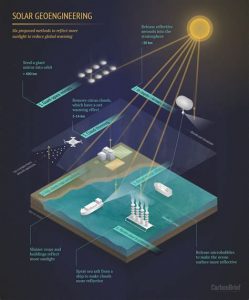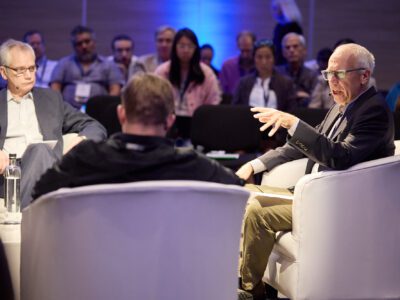A Dangerous Disruption
A startup firm proposes to sell dubious carbon credits from stratospheric aerosol injection
 Last week, MIT’s “Technology Review” reported that a small startup firm is proposing to spray reflective aerosols in the stratosphere commercially as a climate corrective. (Stratospheric Aerosol Injection or SAI.) Previously announced online in the Google Geoengineering Group, the firm is small and new, operating with a claimed total of $750K of venture financing. They say they have thus far launched two small weather balloons, which each released a few grams of sulfur dioxide gas (SO2) in the stratosphere. They assert that their activity will provide two benefits. First, the cooling from the reflective materials they will inject, for which they are already selling carbon credits, charging $10 per gram of SO2 released (!) Based on simple calculations from a recent scientific paper, they claim that each gram of SO2 will offset the heating effect of one ton of CO2 emissions for one year. (The “for one year” part is crucial: stratospheric aerosols stay in the atmosphere roughly a year, so one gram offsets the heating effect of one ton only for the first year after the ton is emitted. After that, the sulfur is gone but the CO2 is still there and heating.) As a second benefit, they claim to be engaged in political symbolism, trying to disrupt a stuck debate over effective climate responses and get people to talk about solar geoengineering – of which stratospheric aerosol injection is the most promising method being discussed.
Last week, MIT’s “Technology Review” reported that a small startup firm is proposing to spray reflective aerosols in the stratosphere commercially as a climate corrective. (Stratospheric Aerosol Injection or SAI.) Previously announced online in the Google Geoengineering Group, the firm is small and new, operating with a claimed total of $750K of venture financing. They say they have thus far launched two small weather balloons, which each released a few grams of sulfur dioxide gas (SO2) in the stratosphere. They assert that their activity will provide two benefits. First, the cooling from the reflective materials they will inject, for which they are already selling carbon credits, charging $10 per gram of SO2 released (!) Based on simple calculations from a recent scientific paper, they claim that each gram of SO2 will offset the heating effect of one ton of CO2 emissions for one year. (The “for one year” part is crucial: stratospheric aerosols stay in the atmosphere roughly a year, so one gram offsets the heating effect of one ton only for the first year after the ton is emitted. After that, the sulfur is gone but the CO2 is still there and heating.) As a second benefit, they claim to be engaged in political symbolism, trying to disrupt a stuck debate over effective climate responses and get people to talk about solar geoengineering – of which stratospheric aerosol injection is the most promising method being discussed.

This news is not particularly surprising. Those following debates on active climate interventions have been expecting – and worrying about – something like this for a few years. The prospect of climate interventions, particularly SAI, might offer large reductions in climate-change risks that are not possible through emissions cuts, adaptations, or atmospheric removals alone, but also raise serious new uncertainties, risks, and governance challenges. Yet proposals to expand research and start governance consultations have met stiff opposition, so little progress has been made in understanding intervention methods and their potential contributions, risks, or governance. The state of understanding and debate thus exhibits a strange dichotomy. On the one hand, the basic mechanism of how stratospheric aerosols can cool the climate is well understood, with some volcanic eruptions providing natural analogues that put rough bounds on efficacy and risk. There are thus strong grounds for confidence that interventions could be made to work. At the same time, there remains deep uncertainty about how to actually do interventions effectively and safely, limit associated risks, and control them effectively, prudently, and legitimately. Yet calls to do the research and governance consultations needed to build understanding and capacity, and to provide the needed resources, have met stiff opposition and achieved little progress. (This may be on the cusp of changing, but it hasn’t yet.)
This near-blockage of research and policy debate on SAI strangely co-exists with a flood of technical proposals, startup firms, and money (private and public) flowing into atmospheric removal of CO2 and other greenhouse gases (carbon dioxide removal, CDR) – interventions that despite big differences in specific methods, risks, and benefits, are sometimes lumped with SAI under the broad heading, “geoengineering.” This CDR boom comes with a gold-rush of carbon-credit proposals, based on technologies and business models ranging from the highly credible and potentially valuable, through to the wildly exaggerated or potentially fraudulent. In such an environment, it’s hardly surprising that someone comes along to jump in and disrupt a dangerously stalled debate on SAI, and jump on the carbon-credits gravy-train at the same time.
In a rare bit of agreement in an often fractious debate, however, no one knowledgeable about SAI thinks what this firm is doing is a good idea. Reactions to the firm’s plans – from those who categorically reject research or policy discussions on SAI through a range of views to those who think research and expanded debate are essential and urgent – have been uniformly critical. (Note: This is the entire range of debate: No one prior to this proposal has supported any near-term move toward operational use of these interventions.)
So what’s the problem? What’s wrong with what the firm is doing, and why are the reactions to such a tiny activity so strong? We don’t have full information about what they are proposing, but based on the information available we can make a few conjectures.
First, there are some concerns that are serious for the prospect of unauthorized SAI interventions in general, but are not serious concerns for what these folks are doing. This activity cannot have any significant global climate effect. And in all likelihood, they are not breaking any current law or regulation.
Could this activity change the climate? Estimates of how much aerosol must be injected to limit climate change vary widely with background scenario assumptions (how fast are emissions being cut) and how much cooling is sought, but they are all on order millions of tons injected, costing $10 to $20 billion, each year. The 1991 eruption of Mt. Pinatubo, widely used as an analogy for SAI, put about 15M tons of sulfur aerosols in the stratosphere and cooled the Earth a little less than 1°C over the following year. The new firm’s initial launches each injected a few grams of sulfur – far less than the sulfur emitted from one trans-Pacific airline flight (~ 50-100 Kg S, depending on the fuel’s sulfur content). Even assuming the maximum weather-balloon payload of a few kilograms per launch, getting an observable climate impact from these would require hundreds of millions of launches per year. While this is probably technically feasible, it is implausible to imagine this scale of activity without the knowledge and participation of states. And if states were involved, they could use dedicated aircraft to disperse the same amount – with more control, less environmental impact, and at much lower cost. (Cost estimates for this stuff are rough and preliminary, but using aircraft looks about five times cheaper than weather balloons.) In a 2019 scenario exercise examining governance responses to four scenarios of unauthorized SAI deployment, the scenario of a widely distributed grassroots effort using weather balloons was the only one the expert participants rejected as pure political symbolism, unable to achieve a meaningful climate impact.
That the firm’s activity is probably not breaking any laws is closely related to its tiny scale. Launching weather balloons is a very lightly regulated activity, pursued by hobbyists and citizen scientists in many countries. In the United States, you don’t even need a permit for individual launches, so long as you keep the payloads small (the few Kg for which weather balloons are designed), don’t fly an operating cellphone, don’t drop anything without a reliable parachute, and stay away from busy or controlled airspace. (Relevant FAA regulations here, FCC regulations here, with a clear summary from a citizen-science NGO here). The tiny quantities released from each balloon would also escape existing environmental controls, either by falling below de minimus numerical thresholds or by not falling within specific identified categories of regulated activity. Multiple domestic laws and international treaties are “relevant” to the activity, but it does not fall under their specific concrete controls. If the aggregate scale of the activity expanded a lot or came to involve significant government participation, it would very likely fall under environmental impact assessment requirements. But at present, and under any reasonably likely expansion, it appears not to be violating any law.
So if it can’t have a significant climate or environmental impact, and it’s not breaking the law, what’s the problem? Is this just a silly distraction, or could it do actual harm? In my view, it could do real harm, but this harm would come not from any direct impact of the releases – which are trivial for good or ill – but from its seeming precedent and how it might influence larger climate debates. There are a few grounds for objection.
First, whatever your view on the merits or risks of SAI in general, it is a highly unsuitable activity for pursuit by commercial enterprises. Any deployment strong enough to do anything will affect the entire world: effects cannot be spatially confined. Specific effects, globally and regionally, will depend on detailed deployment decisions: how much is done, when, where, and how. Given their universal impact, these decisions have to be made intentionally, with consideration of effects, via some legitimate process with input from affected publics and accountability. Given present uncertainties about methods, their effects and risks, there is no way to assess claims about what was done, how successfully, with what side effects, and with what false starts, mishaps, and failures. And there is plenty of incentive for self-interested actors, particularly those with revenues on the line, to misrepresent these. Nothing about this process, except perhaps specific aspects of implementation under some hypothetical future governmental or intergovernmental control, can be entrusted to private firms.
Second, attempting to integrate SAI into emissions and removals accounting by selling carbon credits is a terrible idea. The firm’s simple calculations to support their “1 gram equals one ton’s effect for one year” are based on widely accepted approximations, but these are miles from being reliable enough for either commercial or regulatory purposes.
Even more seriously — and unlike removing greenhouse gases from the atmosphere — SAI perturbs the climate in a different way than greenhouse gases. SAI can offset the effects of greenhouse gases on global-average temperature, but not their total climatic and environmental effects. It thus can at most serve as a stopgap measure that buys time to expand emissions cuts and removals, not a substitute for these. Issuing credits counted on the same scale as emissions and removals obscures this fundamental difference, and increases the risk that SAI will be wrongly taken as a complete replacement for these essential activities. Such a misunderstanding is especially dangerous because these credits would be much cheaper than those associated with emissions cuts or removals: if freely exchangeable, they would drive these other activities out of the market.
There is an urgent need for more research on SAI, including field experiments. But this firm’s launches are not designed to generate credible answers to important scientific questions. They do not control the location or conditions of release, nor monitor what happens after they release the material. These fundamental limitations make the launches useless for research. The firm’s invitation for researchers to propose observational systems for them to incorporate does not solve the problem: well targeted research cannot be done as a bolt-on extra for a project conceived as an operational deployment, however tiny. And since the endeavor is already marketing credits as if the effects were known, reported results won’t be trusted.
In sum, private firms should not be plunging ahead with SAI or other forms of solar geoengineering. They can’t know with any confidence what the effects of their releases are; the carbon credits they are promoting are worthless; and the activity is neither directed toward nor useful for scientific research. It risks identifying solar geoengineering with reckless, ill-informed startup culture, hindering and discrediting by association serious efforts to get needed research and governance consultations underway. There might be one countervailing positive effect. With research on SAI and consultations on its governance long stalled and progressing very slowly, a disruption like this – symbolically important but too small to do any direct harm – might galvanize the research and policy communities and get more serious pursuit of these needed activities. But associated with this potential benefit is the risk that this announcement provokes a hostile public reaction that sets back the serious SAI research and governance efforts along with the unserious ones.
Reader Comments
2 Replies to “A Dangerous Disruption”
Comments are closed.






Sulfur dioxide reacts with water and oxygen in the atmosphere to form sulfuric acid, which falls to earth as “acid rain.” It is regulated by the EPA (75 parts per billion) under the Clean Air Act, as well as other nations because it is dangerous to health and the environment.
Remember Longfellow: “I shot an arrow into the air, it fell to earth I knew not where.”
Hi Jai — You are correct, SO2 is regulated under the US Clean Air Act — but not in ways that would cover these sources without major (and problematic) new regulations or amending the statute. The 75 ppb you mention is the ambient air quality standard for SO2 (NAAQS, Section 109). These ambient standards define requirements for State Implementation Plans and trigger various other regulatory requirements, but they are not source controls, nor do they uniquely specify what these need to be. Controls of sources all apply either to specific types of source (e.g., power plants, industrial boilers), or to sources above some emissions threshold (with thresholds for various pollutants and source types measured in tons per year, not grams). Mobile sources are regulated (CAA Title II) through performance or technology requirements on vehicles and fuels, not direct controls on emissions. None of these controls would apply to intentional releases from these individually tiny mobile sources.